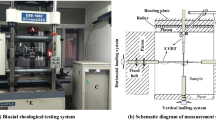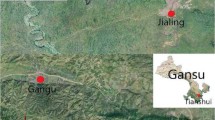Abstract
Shear creep is one of the most important mechanical behaviors of rock discontinuities. The creep mechanism and prediction of starting point of the accelerating creep stage are vital for establishing the creep model and predicting creep failure. In this study, a series of multi-step creep tests are conducted. The three creep stages of shear creep tests are investigated in detail, and a method for predicting the accelerating creep stage is proposed. Distinct nonlinear and local fluctuations caused by cracking are observed in the creep curve. To describe the transition creep stage and steady creep stage, an empirical creep model is established, and the creep characteristics related to the joint roughness coefficient (JRC) and the normal stress are explored in detail using the model’s parameters. The creep process can be described as involving the JRC resistance weakening and frictional resistance compensation, and a model also established to describe this process. The frictional resistance cannot compensate for the loss of JRC resistance; consequently, creep failure occurs. The starting point of the accelerating creep stage can be predicted by combining the JRC weakening and frictional mobilization model and the empirical creep model. A new method for determining long-term strength is also proposed based on the relationships between the starting point creep deformation and the shear creep stress.













Similar content being viewed by others

References
Araki E, Saffer DM, Kopf AJ, Wallace LM, Kimura T, Machida Y, Ide S, Davis E, IODP Expedition 365 shipboard scientists (2017) Recurring and triggered slow-slip events near the trench at the Nankai Trough subduction megathrust. Science 356(6343):1157–1160
Asanov VA, Pan’kov IL (2004) Deformation of salt rock joints in time. J Min Sci 40(4):355–359
Brantut N, Baud P, Heap MJ, Meredith PG (2012) Micromechanics of brittle creep in rocks. J Geophys Res 117(B8):1133–1172
Brantut N, Heap MJ, Meredith PG, Baud P (2013) Time-dependent cracking and brittle creep in crustal rocks: a review. J Struct Geol 52(5):17–43
Barton N (1978) Suggested methods for the quantitative description of discontinuities in rock masses. Int J Rock Mech Mining Sci Geomech Abstr 15(06):319–368
Boidy E, Bouvard A, Pellet F (2002) Back analysis of time-dependent behaviour of a test gallery in claystone. Tunn Undergr Space Technol 17(4):415–424
Christensen RM (1982) Theory of viscoelasticity. Academic Press, New York
Drescher K, Handley MF (2003) Aspects of time-dependent deformation in hard rock at great depth. J South Afr Inst Min Metall 103(5):325–335
Einstein HH, Veneziano D, Baecher GB, O'Reilly KJ (1983) The effect of discontinuity persistence on rock slope stability. Int J Rock Mech Mining Sci Geomech Abstr 20(05):227–236
He ZL, Zhu ZD, Li ZJ (2014) Study of nonlinear creep damage model of marble with structural plane. Sci Technol Eng 14(32):68–72
Heap MJ, Baud P, Meredith PG, Bell AF, Main IG (2009) Time-dependent brittle creep in Darley Dale sandstone. J Geophys Res 114(B7):4288–4309
Kemeny J (2003) The time-dependent reduction of sliding cohesion due to rock bridges along discontinuities: a fracture mechanics approach. Rock Mech Rock Eng 36(1):27–38
Kemeny J (2005) Time-dependent drift degradation due to the progressive failure of rock bridges along discontinuities. Int J Rock Mech Min Sci 42(1):35–46
Mulchrone KF, Mukherjee S (2015) Shear senses and viscous dissipation of layered ductile simple shear zones. Pure Appl Geophys 172(10):2635–2642
Oppikofer T, Jaboyedoff M, Blikra L, Derron MH, Metzger R (2009) Characterization and monitoring of the Åknes rockslide using terrestrial laser scanning. Nat Hazards Earth Syst Sci 9(3):1003–1019
Patton F D (1966). Multiple modes of shear failure in rock. 1st ISRM Congress. Int Soc Rock Mech Rock Eng
Phienwej N, Thakur PK, Cording EJ (2007) Time-dependent response of tunnels considering creep effect. Int J Geomech 7(4):296–306
Potyondy DO, Cundall PA (2004) A bonded-particle model for rock. Int J Rock Mech Min Sci 41(8):1329–1364
Potyondy DO (2007) Simulating stress corrosion with a bonded-particle model for rock. Int J Rock Mech Min Sci 44(5):677–691
Singh DP (1975) A study of creep of rocks. Int J Rock Mech Min Sci 12:271–276
Sakurai S (1978) Approximate time-dependent analysis of tunnel support structure considering progress of tunnel face. Int J Numer Anal Meth Geomech 2(2):159–175
Tan TK (1966) Determination of the Rheological Parameters and the Hardening Coefficients of Clays Rheology and Soil Mechanics. Springer, Berlin Heidelberg, pp 256–272
Tan TK, Kang WF (1980) Locked in stresses, creep and dilatancy of rocks, and constitutive equations. Rock Mech Rock Eng 13(1):5–22
Ulusay R (2015) ISRM suggested methods for rock characterization, testing and monitoring: 2007–2014. Springer, New York
Wang YX, Wang JA, Tang J (2015) Acoustic emission characteristics of fractured rocks during creep shear. Chin J Rock Mech Eng 34(S1):2948–2958
Wang Z, Shen MR, Ding WQ, Jang BA, Zhang QZ (2018) Time-dependent behavior of rough discontinuities under shearing conditions. J Geophys Eng 15(1):51
Wang Z, Shen MR, Tian GH, Zhang QZ (2017) Time-dependent strength of rock mass discontinuity with different values of JRC. Chin J Rock Mech Eng 36:3287–3296
Wang Z, Gu LL, Shen MR, Zhang F, Zhang GK, Deng SX (2020) Influence of shear rate on the shear strength of discontinuities with different joint roughness coefficients. Geotech Test J 43(3):20180291
Xu T, Xu Q, Tang CA, Ranjith PG (2013) The evolution of rock failure with discontinuities due to shear creep. Acta Geotech 8(6):567–581
Zhang F, Xiong YL, Itani Y (2019) Thermo-elasto-viscoplastic mechanical behavior of manmade rock and its numerical modeling. Underground Space 4(2):121–132
Zhang QZ, Shen MR, Wen Z (2011) Investigation on mechanical behavior of a rock plane using rheological tests. J Mater Civ Eng 23:1220–1226
Zhu ZD, Li ZJ, Zhu ML, Wang Q (2009) Shear rheological experiment on rock mass discontinuities and back analysis of model parameters. Rock Soil Mech 30:99–104
Acknowledgements
This work is financially supported by Open research fund of Key Laboratory of Geotechnical and Underground Engineering, Ministry of Education, Tongji University (Grant No. KLE-TJGE-B1903), and National Natural Science Foundation of China (Grant Nos. 51908288, 51809137).
Author information
Authors and Affiliations
Corresponding author
Electronic supplementary material
Below is the link to the electronic supplementary material.
Rights and permissions
About this article
Cite this article
Wang, Z., Gu, L., Zhang, Q. et al. Creep characteristics and prediction of creep failure of rock discontinuities under shearing conditions. Int J Earth Sci (Geol Rundsch) 109, 945–958 (2020). https://doi.org/10.1007/s00531-020-01842-8
Received:
Accepted:
Published:
Issue Date:
DOI: https://doi.org/10.1007/s00531-020-01842-8



